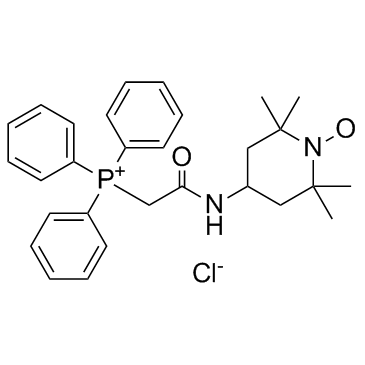Mito-TEMPO |
| Catalog No.GC31682 |
Mito-Tempo is a mitochondria-targeted antioxidant with effective superoxide scavenging properties
Products are for research use only. Not for human use. We do not sell to patients.

Cas No.: 1334850-99-5
Sample solution is provided at 25 µL, 10mM.
Mito-Tempo is a mitochondria-targeted antioxidant with effective superoxide scavenging properties, which converts toxic superoxide molecules into hydrogen peroxide or oxygen and subsequently detoxified to oxygen and water by catalase or glutathione peroxidase[1].
In vitro, Mito-Tempo has a greater protective effect by enhancing superoxide dismutase (SOD) activity and PI3K/AKT/mTOR phosphorylation. Glutamate-exposed cells significantly increased cellular oxidative stress by enhancing ROS production. Glutamate treatment also increased LDH release follows the loss of mitochondrial membrane potential, caused cell viability loss. Treatment with Mito-Tempo not only attenuated the generation of ROS and improved mitochondrial membrane potential but also reduced the neurotoxicity of glutamate in a concentration-dependent manner, which leads to increased cell viability and decreased LDH release[2]
In vivo,Mito-TEMPO pretreatment inhibited inflammation, attenuated LPS-induced liver injury, and enhanced the antioxidative capability in septic mice, as evidenced by the decreased MDA content and the increased SOD activity. In addition, Mito-TEMPO restored mitochondrial size and improved mitochondrial function. Finally, we found that the levels of pyroptosis-related proteins in the liver of LPS-treated mice were lower after pretreatment with Mito-TEMPO [3]
References:
[1]. Liang HL, Sedlic F, et al. SOD1 and MitoTEMPO partially prevent mitochondrial permeability transition pore opening, necrosis, and mitochondrial apoptosis after ATP depletion recovery. Free Radic Biol Med. 2010 Nov 30;49(10):1550-60.
[2]. Mukem S, Thongbuakaew T, et al. Mito-Tempo suppresses autophagic flux via the PI3K/Akt/mTOR signaling pathway in neuroblastoma SH-SY5Y cells. Heliyon. 2021 Jun 15;7(6):e07310.
[3]. Mukem S, Thongbuakaew T, et al. Mito-Tempo suppresses autophagic flux via the PI3K/Akt/mTOR signaling pathway in neuroblastoma SH-SY5Y cells. Heliyon. 2021 Jun 15;7(6):e07310.
Average Rating: 5 (Based on Reviews and 10 reference(s) in Google Scholar.)
GLPBIO products are for RESEARCH USE ONLY. Please make sure your review or question is research based.
Required fields are marked with *




